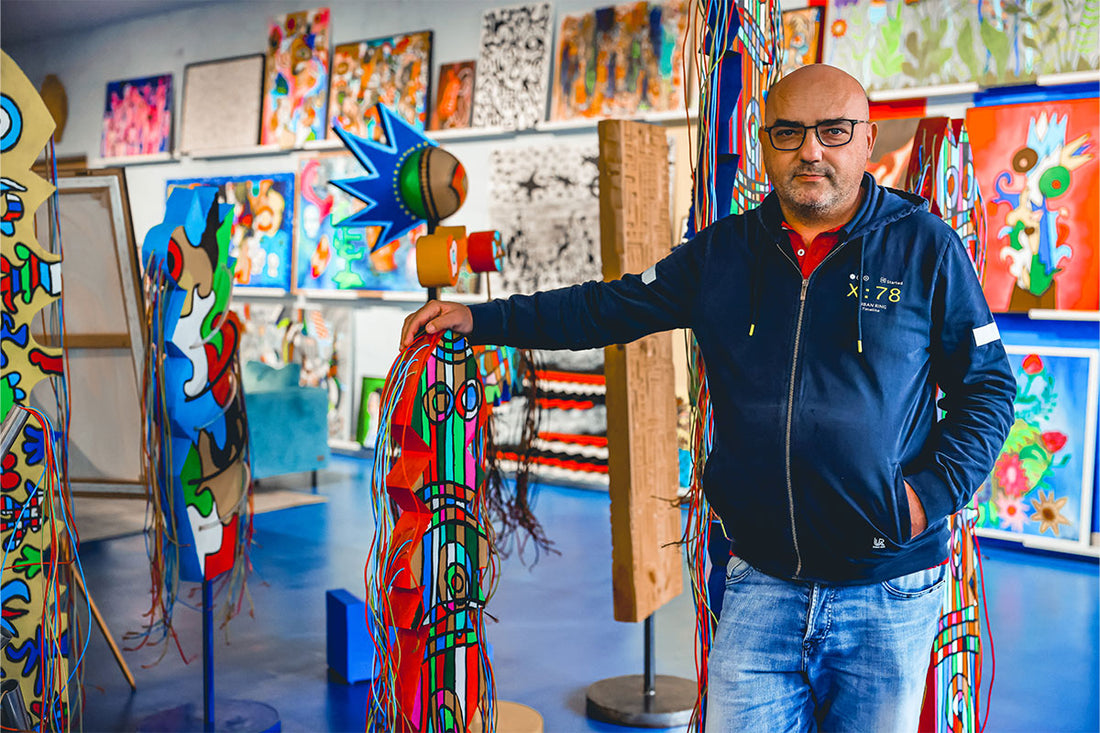In the national panorama of contemporary artistic research Dimitri places himself precisely in a mosaic of multi-directional contexts, founding and supporting a new way of conceiving art, definable with a particular neologism: "Fantagoria".
The new language, of which Dimitri is the creator, has its roots in a previous reality, held between the power of feeling (human feeling) and the abyss of the unconscious.
By investigating his most hermetic and refractory expressions with stylistic sobriety, the artist manages to exhibit his most intimate and profound part to the public, sharing a common feeling with it.
We thus discover that Dimitri Milesi is a self-taught creative who relies on one hand on his instinctual sphere for the color rendering and on the other on his intellectual depth for the graphic creation; two components, logos and pathos , which travel closely in the author's artistic production and which represent the leitmotif of his visual journey.
Born on 10 September 1974, Dimitri Milesi lives and works in Telgate in the Bergamo province. His existence is marked by a real watershed, attributable to the month of September 2009. Dimitri's professional aspects record a rather radical change which also has repercussions in his parallel pictorial activity.
The transition from a stylistic register of a material and purely experimental nature therefore evolves into a triumph of design and light.
Before 2009, in fact, Dimitri's informal painting was dedicated to the abstract landscape and the emphasis of twilight atmospheres, where tonal nuances often acquired dark and nostalgic chromatic accents. In an artist, the language of colors always reveals his state of mind and in the past Dimitri has certainly experienced dark and complicated moments, especially internally and we all know that internal struggles are the most difficult to go through.
Dimitri's "dark" period includes works with an apparently cosmic appearance where matter is indeed the queen of some pictorial cycles, such as the Horizons executed with a mixed technique which varies from the use of expanded polyurethane, to polystyrene and jute.
The new style recovers figuration and leads him to investigate the three-dimensionality of the soul through two-dimensional painting. The variety of the color range is also drastically reduced to reach the sole use of the colors blue, yellow, red and black. From this moment on, the pictorial synthesis carried out by Dimitri takes on symbolic meanings and spiritual connotations. With acrylic he begins to paint with a greater intimate knowledge, aspiring to the divine dimension, revealed by the joy of light.
With this renewed awareness he decided to show himself to the public with his first solo exhibition entitled "From matter towards the infinite" organized in February 2010 at the Circolo Artistico Bergamasco (CAB), located in Via Malj Tabajani 4, followed by a second exhibition revived in November 2010 at the Sile Art Group.
He will return to CAB in February 2011 with his new solo exhibition.
In addition to individual exhibitions, Dimitri Milesi compares himself with his colleagues in collective exhibitions in June 2010 and June 2011 at the CAB respectively, and then exhibits his production at the famous Sala Manzù in Bergamo and participates in the Fiera Arte Padova in November 2011, where he was noticed by the public.
His display gets great appreciation at the Mori Tango Sushi restaurant with its elegant and so sober ideograms.
Dimitri's sixth collective exhibition takes place between 10 and 17 December 2011 in the enchanting setting of Villa Pisani in Venice, following which, from 13 December to 16 January 2012, he exhibits for the first time in Milan at the Galleria Spazio Museale Sabrina Falzone, catalyzing the public's attention thanks to her peculiar versatility.
Beyond the predilection for the large format and the marked multiplicity of stylistic orientations, Dimitri Milesi's value lies in having understood painting in terms of a dichotomy of being. Dimitri therefore deserves the credit for having investigated the complexity of the human unconscious, bringing to light the paradigm of internal conflict between reason and feeling.
Text edited by Sabrina Falzone
Art critic and historian

